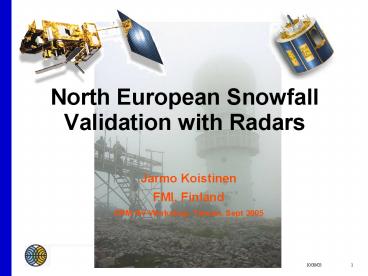North European Snowfall Validation with Radars - PowerPoint PPT Presentation
1 / 24
Title:
North European Snowfall Validation with Radars
Description:
Potential GV site for snow Sodankyl (the northernmost radar, ... phase analysis (rain, sleet, snow) based on surface data (T, ... Snow cases in orange, all ... – PowerPoint PPT presentation
Number of Views:55
Avg rating:3.0/5.0
Title: North European Snowfall Validation with Radars
1
North European Snowfall Validation with Radars
- Jarmo Koistinen
- FMI, Finland
- GPM GV Workshop, Taiwan, Sept 2005
2
- Boreal forest climate
- 100-220 snow cover days/year
- Snow depth in March 20-90 cm
3
FMI weather radar network
8 C-band Dopplers Polar V, dBZ (dBT, W) archived
since 2000 Data availability 99.3 incl.
maintenance and telecommunications in 2004
4
VVP/VAD wind profiles
5
Cold Boreal Forest Climate
- Temperature and snow depth in Sodankylä
Months
Oct Nov Dec Jan Feb Mar Apr May
6
Potential GV site for snow Sodankylä (the
northernmost radar, 67N)
Global CEOP validation site (Nr 29) Coordinated
Enhanced Observing Period (CEOP)
7
Helsinki Testbed 2005-2007- ?
Mesoscale weather research Forecast and
dispersion models development and
verificationInformation systems and technology
integrationEnd-user product development and
demonstrationData distribution for public and
research community
Jani Poutiainen / Finnish Meteorological
Institute
15.6.2005
8
Helsinki Testbed (HTB), 60N, 2005-2007-?A
coastal, mesoscale high latitude research and
development facility (WMO/WWRP endorsement tbd).
All other stations shown except Road
Weather. Average WS distance 9 km (FMI regular 50
km).
- IC lightning system CG lightning system
9
HTB Precipitation Measurements -circles radar
20-60km (0-250 km) -dot manual obs -big diamond
FD12P -small diamond potential FD12P -triangle
autom snow depth -square weighing gauge - plan
2 POSS to be implemented http//testbed.fmi.fi
public realtime data during the campaigns (6
months during Aug 2005 Aug 2006)
10
Vaisala polarimetric radar at HTB, prototype
resultsRHI scans across a bright banddBZ
?HV LDR
11
NORDRAD-composite (25 radars)
12
GEWEX Global Energy and Water Cycle
Experiment WCRP World Climate Research Program
13
WCRP/GEWEX/BALTEXDBZC - Composites of radar
reflectivity
BALTRAD composite 2005-05-28 1415 UTC
- More than 30 radars in 11 countries BALTRAD
- Radar Data Centre at SMHI, Sweden (Daniel
Michelson) - Continuous operation since October 1, 1999
- Resolutions 2?2 km, 15 minutes, 0.4 dBZ
BALTEX Radar Data Center
14
RR - 3 and 12-hour Gauge-adjusted Accumulated
Precipitation Gauges-only Accumulation
- 2?2 km horizontal resolution
- Every 3 and 12 hours
- 32-bit depth
- Wind corrected gauge observations
- 3-hour BALTRAD area
- 12-hour BALTEX Region (see example)
15
Growth of uncertainties in the GV process of
snowfall at ground
16
Work to improve quality(implemented)
- Absolute calibration is still an issue (at best
1-3 dB) - A relative calibration method based on comparing
precipitation accumulation in the overlapping
area of radar pairs. - Elevation angle calibration to better than 0.05
degrees (high latitude sun hits the operational
scans densely during rise and set). - Cold climate phenomena diagnosed applying pattern
recognition and fuzzy logics (in future applying
polarimetry) - Anomalous propagation common introducing strong
sea and ship clutter. - Migration of birds and insects.
17
Antennas tuned mechanically
18
12h accumulation of problems
Clutter Jamming Ships Stroboscope effect
19
(No Transcript)
20
But R(Z)-S(Ze) relations play only a minor role
3000 gauge/radar winter comparisons
- Variable-phase (R or S) method in solid line
- Z-R only in dashed line
- Snow cases in orange, all cases in grey
- Correct Z-R or Z-S is negligible compared to the
increasing bias as a function of range
Gauge/Radar
Range
21
Reality Underestimation far from radarWHY?
Average 12 hourly gauge/radar ratio (dB), summer
Kuopio radar, 3 months winter accumulation (3 dB
colour steps), range 250 km
22
Examples of measured reflectivity profiles
Snow,melting close to ground
Snow
23
Overhanging snow (virga, Altostratus)
Snow, evaporation and residual clutter
1(2)
24
Automatic real time classification of VPRs based
on radar and NWP data (556 471 profiles)
VPR. type (at ground)
25
Snowfall measurements require 20 dBs more
sensitivity than those of rainfall
Cumulative probability distribution of snowfall
in 106 825 profiles
MDS of GPM
26
Reasonable boundary layer winds obtainable 90
of time in winter with sensitive radars (ice
crystals from the ground ?)
27
Climatological profiles based on the measured 2.4
million precipitation profiles
28
Vertical profiles of reflectivity (VPR) in winter
introduce large biases (S) in the radar estimates
of surface precipitation
1(2)
29
Example Bright band at ground
Radar bias i.e. VPR correction for 500 m PsCAPPI
and dry snow S(Ze)
1(2)
30
Profile correction for 500 m PsCAPPI
Example A Snow Case
1(2)
31
Yearly average radar bias for 500 m PsCAPPI as a
function of range
1(2)
32
Improving validation data applying a spatially
continuous VPR correction
Corrected to ground level
Measured
24 h accumulated precipitation Nov 7, 2002, 14
UTC
1(2)
33
Log(G/R), data as previous, note excellent
VPR-effect
34
Overhanging precipitation (OP)
35
Remaining problem complete beam overshooting
in a very shallow snowfall.
36
Precipitation top height March 2001 (snow)
1(2)
37
24 h accumulated precipitation Dec 21, 2002, 21
UTC . VPR correction does not help at the edges
where complete beam overshooting occurs (shallow
snow).
No VPR correction
With VPR correction
1(2)
38
Better accuracy with integrated data but in
proper order!
- Remove non-meteorological echoes and OP.
- Attenuation correction.
- Blocking- VPR-correction intelligent
compositing Precipitation at ground - Time-space variable R(Z) / S(Ze) relations.
- Diagnose areas of total beam overshooting.
- Gauge-radar adjustment.

